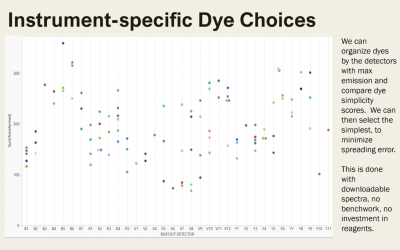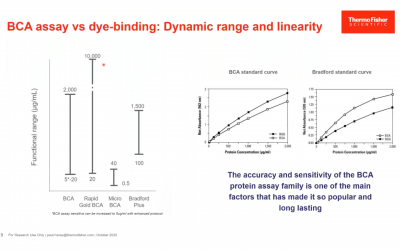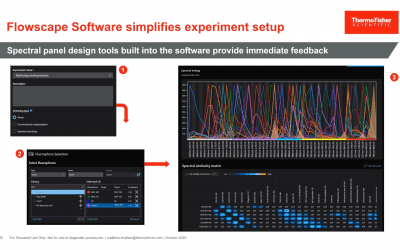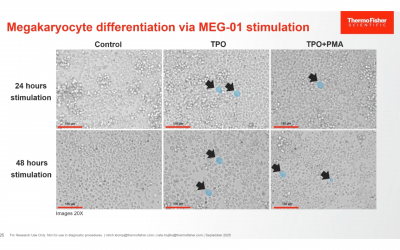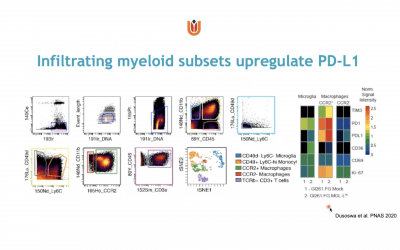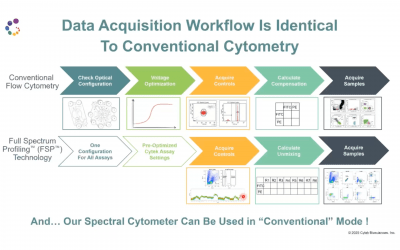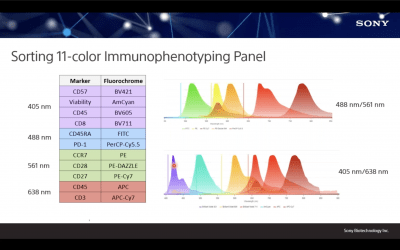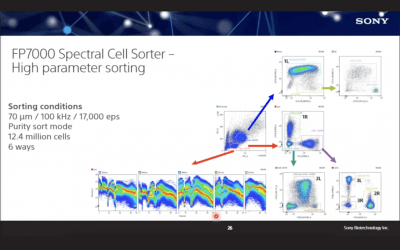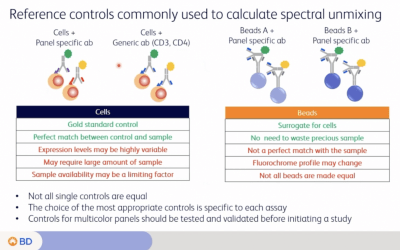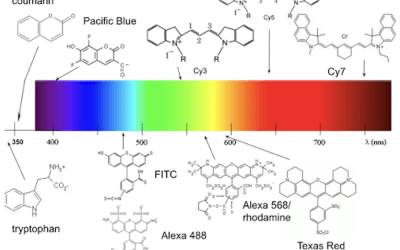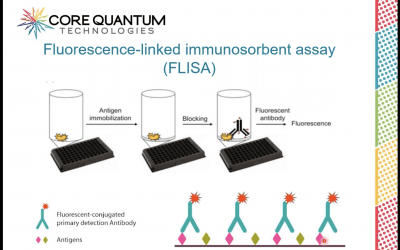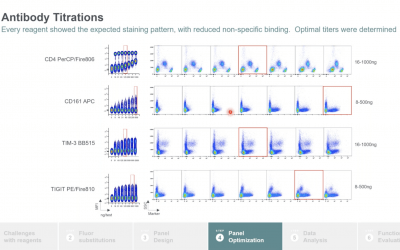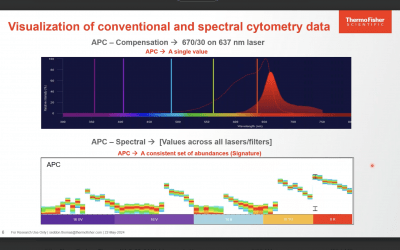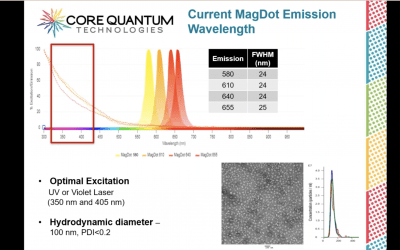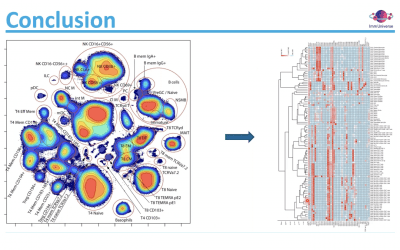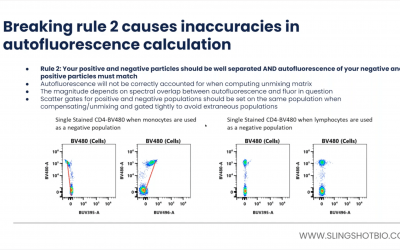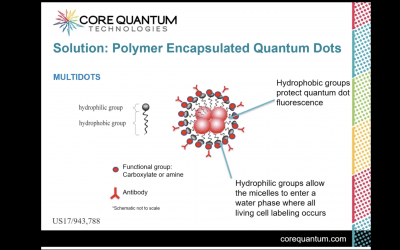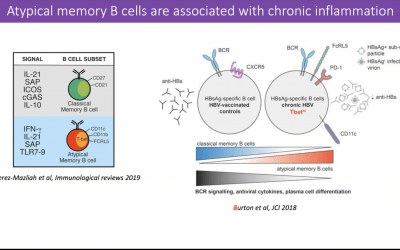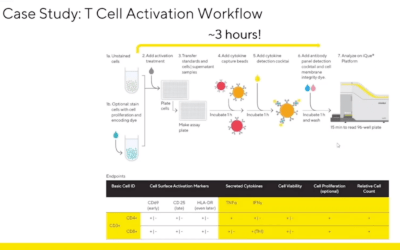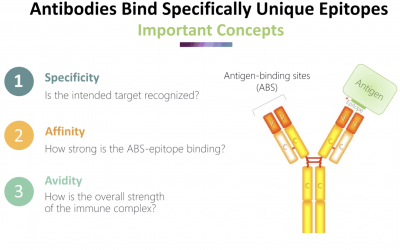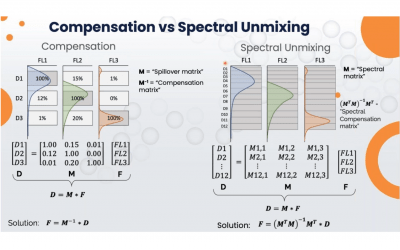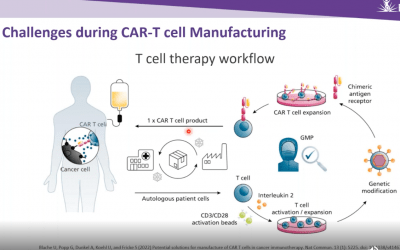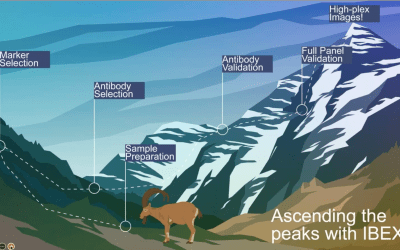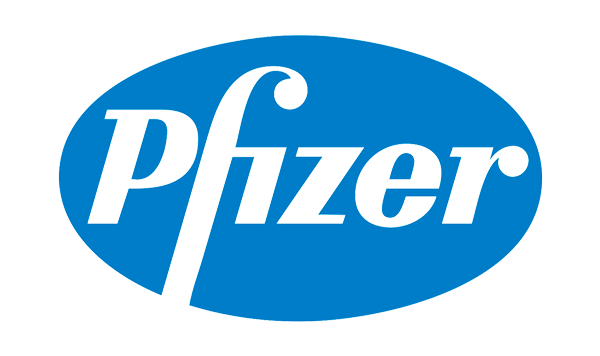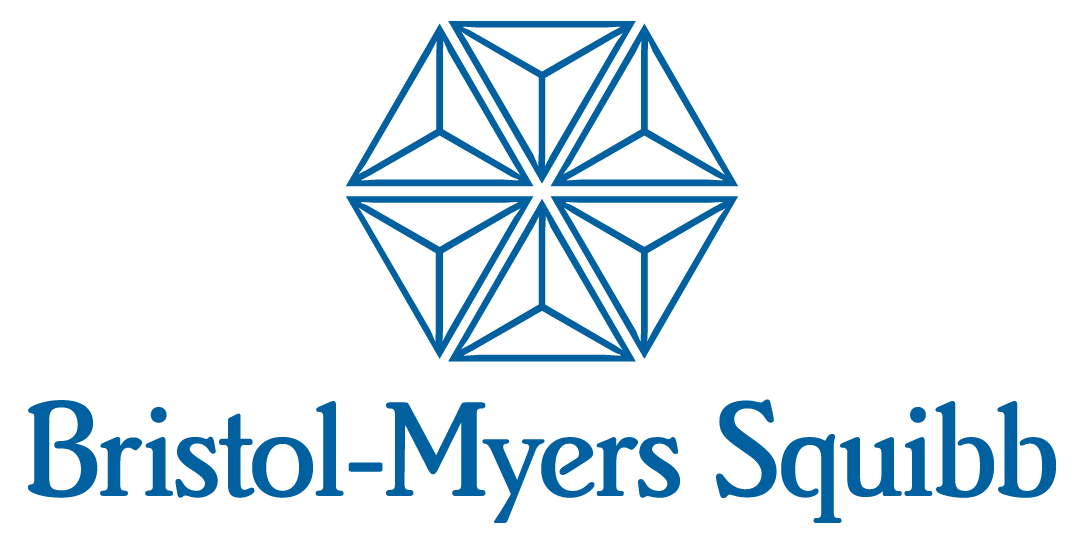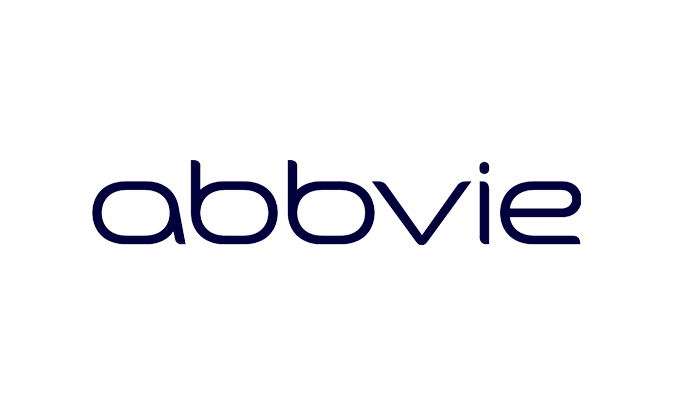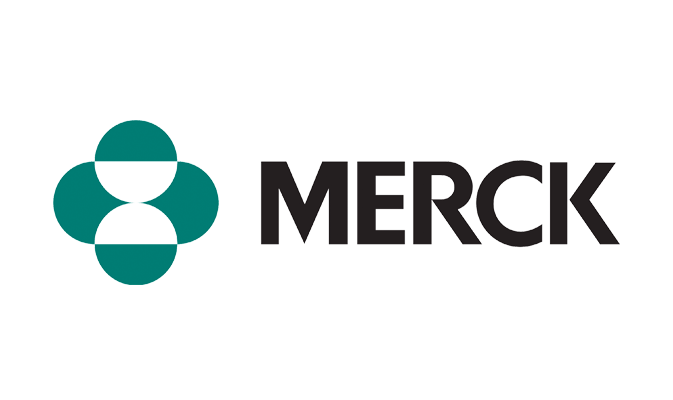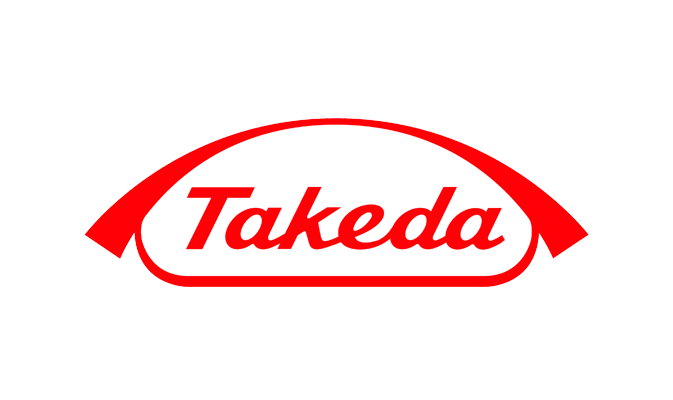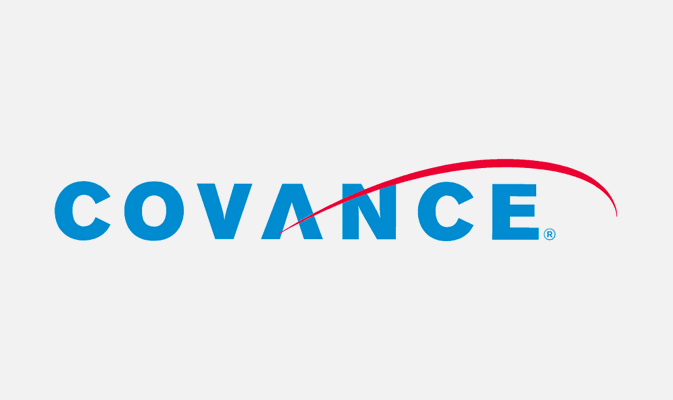Webinars
On-Demand Webinars
This collection of webinars speaks to experimental design across industries that utilize tools that FluoroFinder offers on our platform. We regularly update these webinars as an invaluable resource for our community of users.
Decoding Immune Heterogeneity in Human Disease With High-Dimensional Spectral Flow Cytometry: Insights From Long Covid
When: Thursday, Jan. 22 at 8:00 AM PT
Sponsor: Cytek Biosciences
Speaker: Glenda Canderan, Ph.D., Research Assistant Professor, Division of Asthma, Allergy and Immunology, University of Virginia
Panel Portability: Translating Panels Across Flow Cytometry Platforms
Speaker: Pratip Chattopadhyay, Ph.D., Founder/CEO at Talon Biomarkers, and Co-Founder/CSO at terraFlow
Learn about best practices for panel design, instrument setup, and quality control to improve success of cross-platform translation.
Celebrating 40 Years of Protein Quantitation: Spotlight on the BCA Protein Assay Family
Speaker: Paul Haney, Ph.D., Sr. Manager, R&D, Protein & Cell Analysis at Thermo Fisher Scientific
Learn about principles and chemistry of the BCA assay and how to choose a BCA assay method among all the variations in this webinar.
Standardizing and Simplifying Spectral Cytometry Workflows with Flowscape Software Across Platforms
Speaker: Matthew Shallice, Sr. Staff Scientist & Product Owner, R&D Protein & Cell Analysis at Thermo Fisher Scientific
This webinar explores how a unified software ecosystem enhances reproducibility and efficiency across cytometry platforms, highlighting Flowscape Software.
Optimizing Large Particle Sorting: Characterizing and Evaluating Differentiated Megakaryoblasts Using a Combined Workflow
Speakers: Nate Trujillo, Ph.D. and Mitch Klomp, M.S. – Manager and Applications Specialist of the Flow & Imaging Technologies, Protein & Cell Analysis team at Thermo Fisher Scientific
This webinar explores the integration of imaging cytometry with traditional cell sorting for a transformative approach to cellular characterization, analysis, and sorting.
Reaching New Frontiers in Tissue Immunophenotyping with the EVOS S1000 Spatial Imaging System
Speaker: Juan J. Garcia Vallejo, MD, Ph.D., MBA – Associate Professor and Director of the Microscopy & Cytometry Core Facility at Amsterdam UMC
This webinar looks at how to characterize tumor-associated macrophage subtypes in glioblastoma using advanced single-cell and spatial proteomics profiling approaches.
Selecting the Best: How Fluorochrome Choice Impacts Your Data
Speaker: Robert (Bob) Balderas, VP Biological Sciences, BD Biosciences
This webinar discusses how certain fluorochrome characteristics should be considered during flow cytometry panel design to benefit performance.
Generating Robust Flow Cytometry Results Through Assay Optimization
Speaker: Lily Park, Senior Scientist, Cytek Biosciences
This webinar discusses key aspects of assay optimization that ensure accuracy and reliability of the data.
Accelerate Your Immunological Research with High-Speed, Clog-Resistant Spectral Flow Cytometry
Speaker: Eric Finan, Sr. Manager – Systems Design Engineering, Thermo Fisher Scientific
This webinar discusses how high-speed data acquisition, clog-resistant technology, and acoustic focusing enhance workflow efficiency.
Debunking Myths About Spectral Flow Cytometry
Speaker: Maria C. Jaimes, MD, VP of Scientific Commercialization, Cytek Biosciences
This webinar addresses some of the most common misconceptions that have surfaced around spectral flow cytometry.
Spatial Biology Antibodies: General Considerations and Validation
Speaker: Anna Cartier, Ph.D., Product Manager – Antibodies & Advanced Validation, Thermo Fisher Scientific
This webinar provides a digestible overview of key considerations in spatial biology, with a particular focus on the role of antibodies and the importance of validated antibodies for successful experiments.
Core Quantum Reagents in Spectral Flow Cytometry
Speaker: Kristie Krug, CEO of Core Quantum Technologies
Learn about the incorporation of Core Quantum Technologies reagents in spectral flow cytometry, with a focus on the spectral characteristics of CQT reagents, the similarity index, and spreading error with similar emission profiles.
Sort with Confidence – Ease of Use, Purity, Viability, and Cell Function across Multiple Applications
Speaker: Larry Wong, PhD, Senior Application Scientist, Sony Biotechnology
In this webinar, learn how the MA900 Cell Sorter can be used for multiple applications. We’ll discuss how to optimize system setup for gentle sorting of multicolor panels of immune and stem cells, and single-cell sorting of cancer cell lines.
Evolution of High Parameter Spectral Solutions – Integrating ID7000™ Spectral Analyzer and FP7000 Spectral Sorter Workflows
Speaker: Andy Draghi, PhD, Field Applications Scientist, Sony Biotechnology
In this webinar, we describe the design of 20+ color panels, complete detailed analysis of results using the ID7000™ Spectral Cell Analyzer, and how to sort subsets of interest using the FP7000 Cell Sorter.
Preventing Is Better Than Fixing – How To Optimize Controls And Generate A Correct Spectral Unmixing Matrix
Speaker: Dr. Mirko Corselli, Associate Director, Market Development, BD Biosciences
In this webinar, we will comprehensively review all the main factors that may contribute to spectral unmixing errors and describe the control optimization process.
Is it Fluorophores or Fluorochromes?
Speaker: Kelly Lundsten, VP of Strategic Product Innovation, FluoroFinder
This webinar is an introduction to help you understand fluorophores in the context of cytometry applications.
The Use of MultiDots in Fluorescence-Linked Immunosorbent Assays (FLISAs)
Speaker: Dr. Mythreyi Unni, Principal Research Scientist, Core Quantum Technologies, Inc.
In this webinar, we discuss a step by step protocol implementing the use of MultiDots in a fluorescence-linked immunosorbent assay (FLISA) platform.
The Balancing Act Between Number Of Colors And Data Quality: Lessons Learned From Human Memory T Cells
Speaker: Maria C Jaimes, MD, VP Scientific Commercialization, Cytek Biosciences, Inc.
In this webinar, we discuss the importance of balancing quality and quantity when optimizing robust multiparametric assays, empowered by Cytek’s Full Spectrum Profiling™ (FSP™) technology.
Tips and Tricks for Conventional and Spectral Flow Cytometry: How to Optimize Workflows to Maximize Biological Resolution
Speaker: Seddon Y. Thomas, Ph.D., Staff Scientist, R&D, Protein & Cell Analysis, Thermo Fisher Scientific
In this webinar, we explore optimized workflows and strategies to address common challenges with the transition from conventional to spectral flow cytometry.
Novel Fluorescent and Magnetic Reagents for Life Science Research: The MagDot
Speaker: Kristie Krug, CEO of Core Quantum Technologies
This webinar focuses on the use of MagDots in magnetic cell separation, flow cytometry analysis, and rare protein expression in Yeast Display Libraries. We also discuss protocols, troubleshooting, and types of magnets used in the separations.
Utilizing the ID7000™ Spectral Cell Analyzer to Profile the Human Immune System: Unraveling Immune Profiles and Diseases
Speaker: Laurien Waaijer, PhD Student, Laboratory of Medical Immunology at Radboud University Medical Center
In this webinar, we discuss the use of the ID7000 system in designing a 42-parameter immunoprofiling panel.
Targeted Tumor Destruction: High-Throughput Assessment of ADC Cytotoxicity using Flow Cytometry
Speaker: Kirsty McBain, Scientist, Analytics, Sartorius
In this webinar, we demonstrate the application of high-throughput flow cytometry for evaluating the efficacy of ADCs that target the HER2 protein on cancer cells.
Optimizing Controls for Flow Cytometry
Speaker: Amay Dankar, M.S., Associate Director of Field Applications, Slingshot Biosciences
In this educational webinar, Amay discusses common controls that users need to run their best experiments and the prerequisites for running optimized panels.
Novel Fluorescent and Magnetic Reagents for Life Science Research
Speaker: Kristie Krug, CEO of Core Quantum Technologies
In this webinar, Kristie discusses the development and application of Core Quantum Technology’s highly stable fluorescent reagents with narrow emissions and greater tunability, as well as their unique magnetic and fluorescent reagent that allows for magnetic separation and immediate fluorescent labeling.
An Inflammatory State Remodels the Immune Microenvironment and Improves Risk Stratification in Acute Myeloid Leukemia
Speaker: Audrey Lasry, PhD Department of Pathology, NYU Langone.
In this webinar, we discuss the framework for classifying AML patients based on their immune microenvironment and the use of CITE-Seq to characterize inflammatory responses and the immune microenvironment in AML.
Deriving an Advanced Flow Cytometry Framework for Immunological Data
Speaker: Nina Senutovitch PhD, Senior Scientist, Sartorius.
In this webinar, we discuss how to harness adaptive immune systems to leverage adoptive cell therapies and use advanced flow cytometry to overcome some of the challenges with ACT.
Debunking Antibody Titration Myths
Speaker: Patrick Duncker, Technical Lead, Cytek Biosciences.
In this webinar, we discuss the best practices for antibody titrations, metrics used to evaluate optimal titer, and the impact of flow cytometer setup and configuration on antibody titer.
What’s the Deal with Your Compensation and Unmixing?
Speaker: Andreas (Jack) Panopoulos, PhD, Slingshot Biosciences, Inc.
In this webinar, we discuss the powerful rules governing proper compensation controls and employment of the spillover spreading matrix to reduce errors and avoid loss of resolution, respectively.
A Serum-Free, Chemically-Defined Workflow for T Cell Therapy
Speaker: Zayda Piedra, PhD, Product Development Scientist at BioLegend
In this webinar, we will go over current challenges in the cell therapy industry and what we can do better, BioLegend’s emerging solutions for T cell therapy – closing the gaps, one at a time, and the importance of bioprocessing reagents manufactured with consistent, high-quality well-defined components.
Highly Multiplexed Imaging of Diverse Tissues Using IBEX
Speaker: Andrea Radtke, Ph.D. and Dr. Ziv Yaniv, Ph.D.
In this webinar, we will go over methods to study normal and malignant lymph nodes and topics related to multiplexed tissue imaging, namely: optimal tissue processing, working with fixed frozen and FFPE specimens, overcoming autofluorescence, identifying appropriate reagents, validating antibodies, and creating organ mapping antibody panels (OMAPs).

